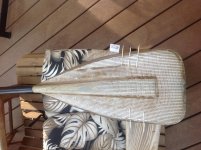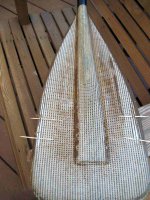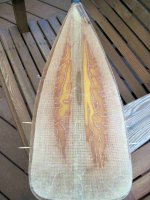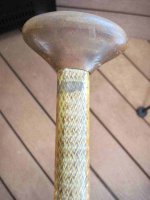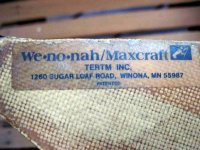The paddle is fairly light weight. My current thinking is to use some 4 oz s glass on both sides (seems a nice paddle and worth buying some s glass) and dynel around the edges. Mix carbon in the epoxy for UV protection and a uniform black finish color. Peel ply for the finished look on the blade. Am I heaed in the right direction???
Sounds about right, I guess. I’m still trying to wrap my head around how the blade faces got into that condition. The one side looks almost like prolonged UV exposure and the other side like a Rorschach test. I see Trucker mudflap girls dancing around a campfire.
4oz fiberglass cloth on one side at a time with the blade held level. Trace out a blade shaped template and use that to cut the glass. I cut the glass a little larger than the paddle blade and try to make sure the drooped cloth perimeter is epoxy adhered to the edge of the blade. Peel ply over that
It takes some repeated convincing as the epoxy sets up to get the cloth edges to maintain that shape and adhesion along the edges. Eventually decide that is as good as it gets/epoxy is firming up. You will need to cut and sand the needle sharp projections of stray cloth off before doing the other side. If you have a little raised cloth “lip” you can fill that with thickened G/flex, or even some kind of FRP “cord” for blade edging. Carbon fiber tow is near weightless.*
Cutting the cloth on the bias might help it lay down along the sharper blade curves, but that wastes a lot of cloth.
Add some graphite powder to the epoxy mix if you are going for black blades. You could also try adding a tiny dab of black pigment, but pigment doesn’t provide much color unless it is being sucked up by bare fabric.
Let it cure, sand it lightly, alcohol wipe and spray it with black paint for some UV top coat.
*One beware, it is easy to add weight to a paddle, and it doesn’t take much weight to throw off the balance of a well designed blade. Even an extra ounce can make a noticeable difference.

